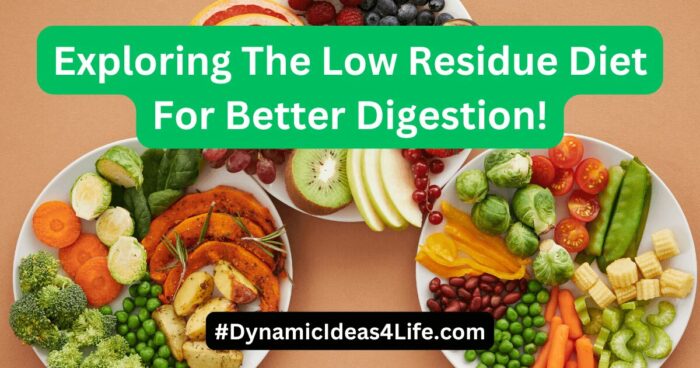Have you heard of the Low Residue Diet before? I hadn’t myself until recently but certainly after finding out about what this is I felt it was something that would be good to write a blog post about. For anyone who suffers from digestive issues I really think this might be something to look into – because what this does is ultimately lower the demands of the digestive system by giving it less work to do.
It basically frees up time and resources to do other things. We likely don’t realize how much goes into digestion and breaking down all the proteins, carbohydrates and fats that we consume on a daily basis but what we should know is that some of these compounds take a lot longer to breakdown than we actually might realise.
In fact, undigested food can cause us many digestive and gut health issues if it is not dealt with accordingly.
These include symptoms such as;
- Diarrhoea,
- Abdominal Pain,
- Bloating and
- Gas (just to name a few)
Just these 4 can all wreak havoc on our day-to-day life activities.
None of these are ever pleasant and whilst medication and other treatments might help manage these symptoms, it’s our diet that plays a crucial role in supporting our body as it carries out its maintenance.
Yet, there are many variables that might be considered when it comes to dieting and specifically The Low Residue Diet is a good example of this.
Exactly why in this article we will provide a comprehensive overview of the Low Residue Diet, explaining what it is, who can benefit from it, how it works, and much, much more.
Key Takeaways
- A Low Residue Diet is a dietary approach that limits the intake of high-fibre foods to reduce the amount of undigested material in the gut.
- People with Digestive Disorders such as Crohn’s disease, ulcerative colitis, and diverticulitis can benefit from a Low Residue Diet.
- A Low Residue Diet works by reducing the amount of undigested material in the gut, which can help alleviate symptoms such as Diarrhoea, Abdominal Pain, Bloating and Gas.
- Foods to avoid on a Low Residue Diet include whole grains, nuts, seeds, raw fruits and vegetables, and high-fibre cereals.
- Foods to include on a Low Residue Diet include refined grains, lean proteins, cooked fruits and vegetables.
So now let’s take a look at this…
Exploring The Low Residue Diet: A Game-Changer For Better Digestion
So, plenty of ideas to think about here – what to eat, and what not to eat but let’s explore this a bit further.
What Is a Low Residue Diet?
The Low Residue Diet (or Low Fibre Diet) is a dietary approach that aims to reduce the amount of Dietary Fibre and other Indigestible materials in the diet. It is often recommended for individuals with digestive disorders such as Crohn’s Disease, Ulcerative Colitis, Diverticulitis, and IBS.
Unlike other diets for Digestive Disorders, which may focus on eliminating specific food groups or ingredients, the Low Residue Diet primarily focuses on reducing the overall fibre content in our diet Instead.
It in theory means that we are effectively consuming food sources that don’t require as much effort to digest.
For instance, something like a tough bit of meat would take more work to digest than say a banana or boiled carrots. Like, I know for one in the past that I never really thought about any foods being harder to digest than others but now I know about the Low Residue diet it makes sense how I can eat somethings and just want to fall asleep and at other times I can eat and feel a quick release of energy.
Being more conscious and knowledgeable about what we put inside of us can make a significant difference to how we feel in regards to health and wellbeing but for sure this kind of tinkering with our biological mechanics is a quite interesting experiment to participate in.
So let’s take a look at this.
Who Can Benefit from a Low Residue Diet?

For those of us that suffer with digestive disorders there are many benefits that can come from a Low Residue Diet. Anyone with;
- Crohn’s Disease,
- Ulcerative Colitis,
- Diverticulitis, and
- IBS (Irritable Bowel Syndrome),,,
>>May want to learn more about this so they can try themselves.
With these conditions in particular the digestive system is sensitive to certain foods, leading to symptoms such as Diarrhoea, Abdominal Pain, and Bloating.
In less serious cases just plain old Indigestion is a good reason to try this diet out but ultimately by following a Low Residue Diet, individuals can reduce the amount of fibre and other indigestible materials in their diet, which can help manage these symptoms.
You can maybe understand what this kind of diet does just from reading what I’ve shared already but just to further clarify what all of this actually is…
How Does Low Residue Dieting Work?
A Low Residue Diet works by minimizing the amount of indigestible material—fiber and other remnants—left in your digestive tract after meals. Residue refers to what remains in your bowel after digestion, which largely comes from high-fiber foods such as whole grains, raw fruits, and vegetables.
By reducing these elements, the diet lightens the workload on your intestines and decreases the frequency and size of bowel movements.
This approach is particularly helpful for individuals dealing with gastrointestinal conditions like Crohn’s disease, ulcerative colitis, or diverticulitis, as it helps to avoid irritation or blockages in the digestive tract.
Additionally, for patients preparing for or recovering from surgery or undergoing certain medical treatments, a Low Residue Diet provides much-needed relief by promoting a smoother, less strenuous digestive process.
Low Residue Dieting is not about deprivation; it’s about strategically selecting easily digestible foods such as white bread, refined cereals, well-cooked vegetables without skins, and lean proteins.
By doing so, the diet allows your digestive system to rest and heal while still providing the essential nutrients your body needs.
Foods to Avoid on a Low Residue Diet
On a Low When following a low residue diet, the key is to avoid foods that are high in fiber or have tough, indigestible parts that could leave residue in your digestive tract. Here’s a list of foods to steer clear of:
Fruits and Vegetables
- Raw fruits and vegetables, especially those with skins, seeds, or tough fibers (e.g., apples, berries, broccoli, corn).
- Dried fruits like raisins, apricots, and prunes.
- Vegetables that are harder to digest, such as cauliflower, kale, and Brussels sprouts.
Grains and Breads
- Whole-grain bread, pasta, rice, and cereals.
- Seeds, nuts, and granola.
- Baked goods made with whole-wheat flour or containing added nuts and seeds.
Proteins
- Legumes, including lentils, beans, and chickpeas.
- Tough or fatty cuts of meat.
- Processed meats with added spices, like sausage or salami.
Dairy
- Yogurt or cheese with fruit chunks, seeds, or nuts.
- Milk and cream, if they aggravate your digestion (may vary by individual).
Snacks and Sweets
- Popcorn, chips, and crackers made from whole grains.
- Desserts with nuts, seeds, or dried fruit.
Beverages
- Juices with pulp, such as orange or pineapple juice.
- Caffeinated drinks or alcohol, if they cause irritation (may vary by tolerance).
Avoiding these foods helps reduce fibre intake and ensures your digestive system has less residue to process, which can ease discomfort and promote better digestion.
How Healthy Is The Low Residue Diet?
I think this is a great question because for those opting for this type of diet they are potentially cutting out a lot of nutrient dense foods. By eliminating foods rich in fibre, individuals may inadvertently limit their intake of essential vitamins, minerals, and antioxidants crucial for maintaining optimal health.
However, as a temporary measure at least this can be a great way to maintain a healthier gut by breaking down undigested residue.
Yet, still it’s Important to approach this type of diet with caution.
The prolonged exclusion of fibre-rich foods could lead to imbalances in gut microbiota, potentially compromising digestive health in the long run.
Nevertheless, in specific medical contexts, such as pre-operative preparation or during acute phases of gastrointestinal disorders, the Low Residue Diet can serve as a therapeutic tool to reduce bowel movements and ease gastrointestinal discomfort.
In these instances, it’s crucial to work closely with healthcare professionals to ensure nutritional needs are met through appropriate supplementation and monitoring.
Foods to Include on a Low Residue Diet
While a Low Residue Diet restricts high-fibre foods, there are still plenty of tasty options available. Low-Fibre Foods that are good to eat on a Low Residue Diet include;
- White Bread,
- Refined Grains,
- Lean Meats such as Poultry, and Fish,
- Eggs,
- Dairy Products,
- Cooked Fruits and Vegetables without Skins or Seeds,
- Well-Cooked Pasta or Rice.
These foods are easier to digest and less likely to cause symptoms in individuals with digestive disorders.
Low Residue Diet For Colonoscopy
A crucial application of the Low Residue Diet is its role in preparing for a colonoscopy, a diagnostic procedure used to detect abnormalities in the colon and rectum, such as polyps or colorectal cancer.
The primary goal of adopting a Low Residue Diet in this context is to minimize the presence of undigested food particles and fecal matter in the digestive tract, ensuring optimal visualization of the colon during the procedure.
Colonoscopy preparation typically involves a multi-day dietary regimen aimed at emptying the colon effectively.
In the days leading up to the procedure, individuals are advised to consume a Low Residue Diet, which typically includes easily digestible foods that leave minimal residue in the colon.
This often involves avoiding high-fiber foods such as whole grains, nuts, seeds, raw fruits, and vegetables, as well as tough or fibrous meats.
Instead, individuals undergoing colonoscopy preparation are encouraged to opt for low-fibre alternatives.
Clear liquids such as broth, gelatin, and fruit juices without pulp may also be included in the diet to further facilitate colon cleansing.
By adhering to a Low Residue Diet in the days leading up to a Colonoscopy, patients can help ensure that their colons are adequately cleansed, optimizing the accuracy and effectiveness of the procedure.
Sample Low Residue Diet Meal Plan
Following a Low Residue Diet doesn’t mean sacrificing flavor or nutrition. With careful planning, individuals can create satisfying and nourishing meals while minimizing fibre intake.
For a good example of what this type of meal plan could typically involve – here are just a few examples;
Breakfast:
- Scrambled eggs made with egg whites and topped with a sprinkle of low-fat cheese
- White toast made from refined grains, served with a small amount of butter or margarine
- A glass of strained fruit juice, such as apple or grape, without pulp
Mid-Morning Snack:
- Greek yogurt, plain or flavoured with low-fiber options like vanilla or lemon
- A small handful of peeled and sliced banana
Lunch:
- Grilled chicken breast served with white rice
- Steamed carrots and zucchini, cooked until tender
- A clear broth-based soup, such as chicken noodle without the noodles
- A slice of white bread with a thin spread of cream cheese
Afternoon Snack:
- Smooth peanut butter spread on white crackers or rice cakes
- A cup of fruit-flavoured Jelly without added fruit pieces
Dinner:
- Baked salmon fillet with lemon and herbs
- Mashed potatoes made with peeled potatoes and low-fat milk
- Cooked spinach, well-cooked to reduce fibre content
- A dinner roll made from refined flour
- A small serving of canned fruit in syrup, such as peaches or pears
Evening Snack:
- A small bowl of vanilla pudding made with low-fat milk
- A cup of herbal tea, such as chamomile or peppermint, without added fruit or herbal pieces
Throughout the day, it’s important to stay well-hydrated by drinking plenty of clear fluids such as water, herbal tea, and strained fruit juices.
While following this sample meal plan, individuals should avoid foods high in fibre, including whole grains, nuts, seeds, raw fruits and vegetables, and high-fibre cereals or breads.
Tips for Following a Low Residue Diet
Transitioning to a Low Residue Diet may seem challenging at first, but with a few tips, it can become more manageable.
Firstly, meal planning is essential! Plan your meals in advance and make sure to include a variety of low-fibre foods.
Secondly, grocery shopping should be focused on purchasing low-fiber options and avoiding high-fiber foods. Reading food labels can help identify products that are suitable for a Low Residue Diet.
Lastly, it is important to stay hydrated by drinking enough fluids throughout the day. Water, herbal teas, and clear broths are good options.
But, Does The Low Residue Diet Really Work?
The effectiveness of the Low Residue Diet depends on the context in which it’s used. In certain situations, such as preparation for a medical procedure like a Colonoscopy or during acute phases of gastrointestinal disorders, the low residue diet can be highly effective.
I kind of already covered this but just to highlight the specific goals you may want to participate in the Low Residue Diet for;
- Colonoscopy Preparation: The Low Residue Diet is commonly used before a Colonoscopy to clear the colon of any remaining fecal matter or undigested food particles. By reducing fibre intake and consuming easily digestible foods, individuals can effectively cleanse their colon, allowing for better visualization during the procedure.
- Management of Gastrointestinal Conditions: For individuals experiencing symptoms of gastrointestinal conditions such as Crohn’s disease, ulcerative colitis, or diverticulitis, a low residue diet can help reduce bowel movements and alleviate symptoms such as abdominal pain, bloating, and diarrhoea.
By limiting the consumption of high-fibre foods that can exacerbate digestive issues, the low residue diet may provide relief during flare-ups of these conditions.
However, it’s important to note that the Low Residue Diet is typically recommended as a temporary measure and not as a long-term dietary solution.
While it can be effective in achieving short-term goals such as colon cleansing or symptom management, it may not provide all the necessary nutrients for optimal health over an extended period.
So How Long Should You Follow a Low Residue Diet For?
The duration of following a Low Residue Diet will depend on individual circumstances and the specific digestive disorder being managed.
In some cases, a Low Residue Diet may be recommended for a short period of time to allow the digestive system to heal.
In other cases, it may be necessary to follow the diet long-term to manage chronic symptoms. For best results its typically recommended to consult with a healthcare professional or registered dietitian who can provide personalized guidance based on your own individual needs.
What Are The Alternatives?
The Low Residue Diet is just one of several dietary approaches for managing Digestive Disorders. Other diets, such as the FODMAP diet and the Specific Carbohydrate Diet, focus on eliminating specific types of carbohydrates that can trigger symptoms in individuals.
Each diet has its own unique principles and may be more suitable for certain individuals depending on their specific condition and symptoms.
Alternatives to a Low Residue Diet vary depending on the specific dietary needs and health conditions of individuals.
Some potential alternatives that may be considered are:
- High-Fibre Diet: For individuals who do not need to restrict fibre intake, a high-fibre diet can be a beneficial alternative. This diet includes plenty of fruits, vegetables, whole grains, legumes, nuts, and seeds, which provide essential nutrients, promote digestive health, and help prevent constipation.
- Specific Carbohydrate Diet (SCD): The SCD is a restrictive diet that eliminates complex carbohydrates and focuses on consuming easily digestible carbohydrates, proteins, and fats. It may be beneficial for individuals with inflammatory bowel diseases such as Crohn’s disease or ulcerative colitis.
- Low-FODMAP Diet: The low-FODMAP diet restricts certain types of carbohydrates that are poorly absorbed in the small intestine and fermented by gut bacteria, leading to symptoms such as bloating, gas, and abdominal pain. It may be helpful for individuals with irritable bowel syndrome (IBS) or other functional gastrointestinal disorders.
- Gluten-Free Diet: A gluten-free diet eliminates foods containing gluten, a protein found in wheat, barley, and rye. It is essential for individuals with celiac disease or non-celiac gluten sensitivity to avoid gluten-containing foods to prevent adverse reactions and promote intestinal healing.
- Soft or Mechanical Soft Diet: This diet consists of foods that are easy to chew and swallow, making it suitable for individuals with dental problems, swallowing difficulties (dysphagia), or those recovering from surgery. Soft foods include cooked vegetables, tender meats, fish, tofu, eggs, and dairy products.
- Elemental Diet: An elemental diet involves consuming easily digestible, pre-digested nutrients in liquid form. It may be recommended for individuals with severe gastrointestinal disorders, malabsorption issues, or those unable to tolerate solid foods.
- Plant-Based Diet: A plant-based diet emphasizes whole plant foods such as fruits, vegetables, grains, legumes, nuts, and seeds while minimizing or eliminating animal products. It can provide a wide range of nutrients, promote digestive health, and reduce the risk of chronic diseases when properly balanced.
However, in any case It’s essential to consult with a healthcare provider or registered dietitian to determine the most suitable dietary approach based on individual health needs, preferences, and goals.
A personalized dietary plan can help optimize nutrition, manage symptoms, and improve overall well-being.
In Conclusion
Is the Low Residue diet right for you? Well, it certainly can be a valuable tool in managing symptoms of digestive disorders such as Crohn’s disease, ulcerative colitis, diverticulitis, and IBS.
By reducing the amount of fiber and other indigestible materials in the diet, individuals can experience relief from symptoms such as diarrhea, abdominal pain, and bloating.
However, it is important to consider potential risks and side effects, such as nutrient deficiencies and constipation.
Again this can not be stressed enough – Working with a healthcare professional or registered dietitian is crucial to ensure that any Low Residue Diet is tailored to individual needs and at the same time provides adequate nutrition which is itself highly Important.
I shall finish up this article here but if you would like to read more about digestive health check out our page here for all of our articles<<<




Anxiety and Depression best ways to lower blood sugar BiOptimizers blood pressure supplements blood sugar support supplements Digestive Enzymes Supplement digital products Dr Sam Robbins Erectile dysfunction Exercise Gut Health Healthy Living heart health HFL how to lower blood sugar levels How To Lower Cholesterol insulin resistance joint health supplement Keto keto dieting Keto Diet Weight Loss leaky gut supplements leptin resistance list Magnesium deficiency Matt Gallant mental health multivitamins Nootropics nutrient supplements Probiotics Probiotic Supplements proteolytic enzymes reverse type 2 diabetes stress and anxiety stress relief vitabalance vitapost Wade Lightheart weight loss articles weight loss diet plans weight loss product reviews weight loss supplements weight loss supplements that work weight loss tea
Of course, I like your website, but several of your pieces need to have their spelling checked. Several of them contain multiple spelling mistakes, which makes it challenging for me to be honest. Still, I will most certainly return.
OK, Thanks for bringing to my attention I will make sure I check this thanks.
Your blog is a true treasure.
Thank you.
Your blog is a beacon of light in the often murky waters of online content. Your thoughtful analysis and insightful commentary never fail to leave a lasting impression. Keep up the amazing work!
Thank you